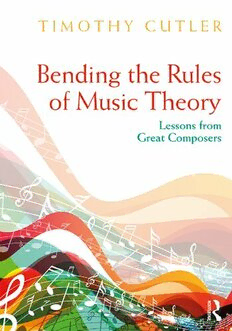
Bending the Rules of Music Theory: Lessons from Great Composers PDF
Preview Bending the Rules of Music Theory: Lessons from Great Composers
BENDING THE RULES OF MUSIC THEORY For students learning the principles of music theory, it can often seem as though the tradition of tonal harmony is governed by immutable rules that define which chords, tones, and intervals can be used where. Yet even within the classical canon, there are innumerable examples of compos- ers diverging from these foundational “rules.” Drawing on examples from composers including J. S. Bach, Mozart, Beethoven, Schubert, Mendelssohn, Chopin, Brahms, and more, Bending the Rules of Music Theory seeks to take readers beyond the basics of music theory and help them to understand the inherent flexibility in the system of tonal music. Chapters explore the use of different rule-breaking elements in practice and why they work, introducing students to a more nuanced understanding of music theory. Timothy Cutler is Instructor and Chair of Music Theory at the Cleveland Institute of Music. BENDING THE RULES OF MUSIC THEORY Lessons from Great Composers Timothy Cutler First published 2019 by Routledge 52 Vanderbilt Avenue, New York, NY 10017 and by Routledge 2 Park Square, Milton Park, Abingdon, Oxon, OX14 4RN Routledge is an imprint of the Taylor & Francis Group, an informa business 2019 Taylor & Francis The right of Timothy Cutler to be identified as author of this work has been asserted by him in accordance with sections 77 and 78 of the Copyright, Designs and Patents Act 1988. All rights reserved. No part of this book may be reprinted or reproduced or utilised in any form or by any electronic, mechanical, or other means, now known or hereafter invented, including photocopying and recording, or in any information storage or retrieval system, without permission in writing from the publishers. Trademark notice: Product or corporate names may be trademarks or registered trademarks, and are used only for identification and explanation without intent to infringe. Library of Congress Cataloging-in-Publication Data A catalog record for this title has been requested ISBN: 978-1-138-47823-7 (hbk) ISBN: 978-1-138-47824-4 (pbk) ISBN: 978-1-351-06916-8 (ebk) Typeset in Bembo by Swales & Willis Ltd, Exeter, Devon, UK For Amelia May you find your passion as I have with music CONTENTS Acknowledgments xi Preface xii 1 “Rules” 1 2 Consonance and Dissonance 13 Classifying Consonance and Dissonance 13 Intervals and Musical Context 14 Consonant and Dissonant Perfect Fourths 16 Functionally Flexible Intervals 17 Dissonant Perfect Fifths 18 Dissonant Perfect Octaves 19 Dissonant Perfect Unisons 21 The Stability of Major and Minor Triads 24 Unstable Triads and Nonharmonic Tones 26 Unstable Triads and Hypermeter 26 Stable Diminished and Augmented Triads? 27 3 Chord Construction 32 Chordal Doubling 32 Doubling Chordal Thirds 33 Doubling Tendency Tones 35 Incomplete Chords 37 Missing Thirds 37 Incomplete Inverted Chords 39 Missing Roots 40 Other Uses for Incomplete Chords 44 Chord Spacing 48 viii Contents 4 Voice Leading I: Parallel Fifths 52 Good and Bad Parallel Fifths 52 Parallel Fifths and Nonharmonic Tones 53 “Mozart” Fifths 57 Parallel Fifths at Deeper Levels of Structure 57 Illusory Parallel Fifths 59 Full-Voiced Textures 60 “Parallel Fifths” by Octave Transference 62 Enharmonic Parallel Fifths 62 Parallel Fifths between Phrases 63 Parallel Fifths and Arpeggiated Textures 63 Bad Parallel Fifths 64 Avoiding Parallel Fifths 67 Brahms’s Notebook 71 Coloristic Parallel Fifths 72 5 Voice Leading II: Parallel Octaves and Other Procedures 77 Parallel Octaves 78 Fifths and Octaves by Contrary Motion 85 Diminished Fifth–Perfect Fifth 87 Ascending Chordal Sevenths 89 Voice Leading the Cadential 6 95 4 Leading Tones in the Soprano 97 When Two Voice-Leading Principles Collide 99 6 Harmonic Syntax I: Contrapuntal Chord Function 100 Harmonic Function 101 The Limits of Harmonic Function 101 Stylistic Considerations 102 The Pitfalls of Seeking Syntactical Irregularities 103 Standard Harmonic Syntax Obscured by Nonharmonic Tones 104 Harmonic Sequences 105 Parallel 6 Chords 109 3 Contrapuntal Chord Function 109 Passing Chords 109 Neighbor Chords 111 The Limits of Contrapuntal Chord Successions 113 I as an Unstable Contrapuntal Chord 114 Chords that Support Contrapuntal Gestures in Upper Voices 115 The Dangers of Contrapuntal Chord Function 118 7 Harmonic Syntax II: More Unorthodox Progressions 120 V(7)–IV 120 V(7)–II(7) 129 Contents ix Predominants Progressing “Up” by Third 130 II6–I 133 5 II4–I 135 2 II–I 136 ♭II6–I(6) 140 Multiple Explanations for Unusual-Looking Syntax 142 V 4–I5 143 2 3 Harmonic Retracing 145 Voice-Leading Function 146 8 Deviant Harmonies I: Forbidden and Functionally Flexible Chords 149 “Forbidden” Harmonies: 5 and 6 Diminished Triads 149 3 4 Functional Flexibility: Half Cadences with V7 153 Functional Flexibility: Decorative and Predominant VII7 Chords 154 Functional Flexibility: III and VII 158 Misleading Labels: III6 and VI6 165 Misleading Labels: Illusory Applied Chords 168 An Illusory V7 174 9 Deviant Harmonies II: 6 Triads 176 4 Dissonant 6s 177 4 Consonant 6s 178 4 Arpeggiated 6 179 4 Oscillating 6 180 4 6s by Delayed Bass Resolution and Delayed Bass Entrance 182 4 Notable 6 Triads in Works by Beethoven and Chopin 184 4 Can We Invert the Cadential 6? 187 4 Voice Exchanges 187 The Inverted Cadential 6 192 4 10 Aberrant Nonharmonic Tones I: Analytical Conundrums 204 Optical Illusions 205 Figuration within the Prevailing Harmony 206 Nonharmonic Tones and the Obfuscation of Harmony 207 Dual Interpretations 208 Ornamenting Ornaments 210 Floating Nonharmonic Tones 215 Nonharmonic Tones and Registral Displacement 217 11 Aberrant Nonharmonic Tones II: Textbook Deviations 223 Passing Tones 223 Escape Tones 226 Suspensions 228 Implied Suspensions and Implied Resolutions 231
